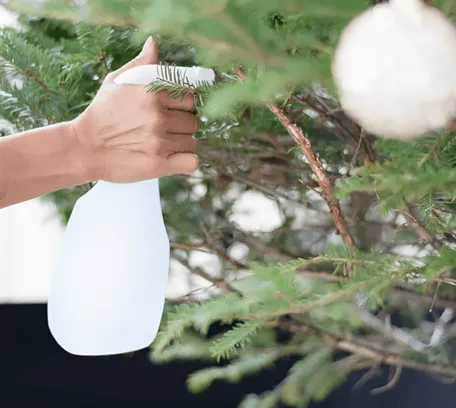

How to Keep Christmas Tree Alive Throughout the Holiday Season
The tradition of decorating a real Christmas tree is a cherished and time-honored tradition for many families around the world. The fresh scent of pine, the shimmering lights, and the joy of hanging ornaments all contribute to the magical ambiance of the holiday season. However, to ensure that your real Christmas tree remains vibrant and healthy throughout the holiday season, it’s essential to take proper care of it.
This guide offers essential tips to keep your real Christmas tree fresh and vibrant from setup to takedown.

1.Selecting the Perfect Tree
Choose a local supplier:
Opting for a local supplier has multiple benefits. Local trees tend to be fresher, as they are often cut shortly before purchase, ensuring a longer-lasting tree. Additionally, supporting local farms not only reduces the environmental impact of long-distance transportation but also helps sustain the local economy.
When visiting a local farm, ask about the types of trees available. Some common varieties include Fraser fir, Douglas fir, and Scotch pine, each with unique qualities like needle retention, scent, and branch strength. Many farms allow you to choose and cut your own tree, providing a more personalized experience.

Check for freshness:
Gently run your hand along the branches to make sure the needles are pliable and don’t fall off easily. Avoid a tree with brittle, dry needles.To ensure your tree is fresh, gently grasp a branch and run your hand along it. The needles should feel soft and pliable rather than brittle, and they should stay firmly attached to the branch. A fresh tree will also have vibrant green needles, and you might notice a pleasant pine scent when you touch it.
Another test is to give the tree a gentle shake. If only a few needles drop, it’s a good sign of freshness. However, if the tree sheds heavily, it may be dry or cut some time ago. Prioritizing a tree with flexible needles helps ensure it will last longer and maintain its color and shape throughout the holiday season.

Smell test:
A fresh tree should release a robust, natural pine scent, which is one of the joys of having a real Christmas tree indoors. When you get close to the branches or rub the needles gently between your fingers, the aroma should be easily noticeable. A weak or stale smell may indicate that the tree is past its prime or has been cut for some time.
If the tree doesn’t emit that signature pine scent, consider checking other options, as this is often a good indicator of freshness and overall health. A strong scent typically means the tree’s oils are still intact, which helps it stay vibrant longer.

2.Tree Preparation :
Before bringing your tree , ask your supplier to shake it to remove any loose needles and debris. This will help keep your home cleaner and your tree fresher. If the lower branches of your tree touch the ground, trim them to prevent moisture absorption from the floor.

3. Wrap the Tree During Transport:
If you transport the tree on the roof of your car, protect it from the wind by wrapping it in a tarp or tree wrap. Wind exposure can accelerate needle drying during transit, impacting the tree’s overall health.

4. Caring for Your Tree from Day One
Recut the trunk:
Making a fresh cut at the base of the trunk is essential for your tree’s longevity. When a tree is initially cut, its capillaries—tiny tubes that transport water up the trunk—begin to seal off, which limits water absorption. By removing an inch or so from the bottom, you reopen these capillaries, allowing the tree to take in water more effectively.
For best results, make the cut right before placing the tree in the stand. If the tree was cut hours before, the capillaries might begin to seal up again, reducing water intake. Using a sturdy tree stand that holds plenty of water is also key; a well-hydrated tree will stay fresh, hold onto its needles longer, and be less of a fire hazard.

Proper water supply:
A tree stand with a large water reservoir is crucial to keep your tree hydrated throughout the holiday season. A fresh tree can absorb a significant amount of water, especially in the first few days after being set up. Aim to provide approximately one quart of water for each inch of the trunk’s diameter every day. For instance, if your tree’s trunk is four inches in diameter, it will need around four quarts (or one gallon) of water daily.
Use lukewarm water when filling the tree stand. Cold water can shock the tree’s root system, while hot water can promote microbial growth. Some people like to wrap their tree stand with a decorative tree skirt. This not only adds to the festive atmosphere but also helps to keep the water reservoir dark and cooler, reducing water evaporation.

Regularly check the water level:
Regularly checking the water level in your tree stand is essential for maintaining a healthy and vibrant tree. Make it a daily routine to inspect the water level and refill it as needed, especially during the first week when the tree absorbs the most water.
Ensure that the base of the trunk remains submerged, as even a brief period without water can cause the cut end to seal, hindering water uptake. Keeping the stand filled will help prevent needle drop and maintain the tree’s color and fragrance throughout the holiday season. A hydrated tree not only looks better but also reduces the risk of fire, making it a crucial aspect of holiday safety.
If you’re worried about forgetting to water your tree, invest in a tree watering system that can help maintain a consistent water supply.

5.Use the right additives:
The key is to keep the tree well-watered, as a consistent supply of water allows it to absorb the necessary moisture to stay healthy. If you do choose to use additives, ensure that they are safe for the tree and won’t interfere with its water absorption. However, many tree experts recommend sticking to plain water, as it typically works just fine for keeping your tree looking its best throughout the holiday season.
While some people use additives like aspirin, sugar, or commercial tree preservatives in the water to extend the life of their Christmas tree, clean, fresh water is often sufficient for maintaining its hydration and freshness.
If you have a large tree and a busy household, consider assigning watering responsibilities to different family members. This ensures that the tree receives consistent care, and everyone can participate in the joy of maintaining a vibrant centerpiece.

6.Branch care:
Prune Dead Branches
As the holiday season progresses, some lower branches may dry out and lose their needles. Use pruning shears to remove these dead branches, promoting air circulation and allowing the tree to focus on maintaining the health of its remaining foliage.

Use a tree preservative spray:
Some commercial sprays claim to reduce needle drop and keep your tree looking fresher longer.Spritzing your tree with water periodically can help maintain humidity levels and reduce needle drop.Using a humidifier in the room with your tree can help maintain the tree’s moisture and reduce drying out.

7.Limit Display Time:
While the allure of a beautifully decorated tree is undeniable, limiting the time your tree spends indoors can help maintain its vitality. Consider bringing the tree indoors a couple of weeks before Christmas and moving it outdoors afterward to prolong its life.

8.Maintaining Your Tree Throughout the Season
Keep it cool:
To maintain your tree’s freshness and prevent it from drying out, it’s important to keep it away from heat sources. Position your tree at least a few feet away from radiators, fireplaces, heating vents, and direct sunlight. Excessive heat can accelerate the drying process, leading to needle drop and a shorter lifespan for your tree.
Choosing a cool location not only helps preserve the tree’s moisture but also enhances safety by reducing the risk of fire hazards associated with dry trees. A well-hydrated tree in a cooler spot will stay lush and vibrant throughout the holiday season, allowing you to enjoy its beauty and fragrance longer.
Maintain a Consistent Temperature:
Maintaining a cooler room temperature is crucial for helping your Christmas tree retain moisture and stay healthy throughout the holiday season. Ideally, aim to keep the room temperature between 60°F to 70°F (15°C to 21°C).

9.Rotate the Tree:
To ensure even exposure to light and heat, rotate the tree regularly. This prevents one side from drying out more than the other. Aim to rotate the tree 180 degrees every few days, especially if it’s placed near a window or heat source.

Use LED lights:
Using LED Christmas lights is a smart choice for decorating your tree, as they generate significantly less heat compared to traditional incandescent lights. This reduced heat output helps minimize the risk of drying out your tree, which can lead to needle drop and a shorter lifespan.
Moreover, because LED lights are cooler, they lower the risk of fire hazards, making them a safer option for holiday decorating. LED lights are also energy-efficient and have a longer lifespan, allowing you to enjoy their vibrant glow for many seasons without needing frequent replacements. Opting for LED lights not only enhances the safety and longevity of your tree but also contributes to a more sustainable holiday celebration.

10. Avoid overloading ornaments:
When decorating your Christmas tree, it’s important to avoid overloading it with heavy ornaments. While it can be tempting to hang as many ornaments as possible, excessive weight can stress the branches, leading them to droop and lose their shape.
To maintain a balanced and aesthetically pleasing look, distribute ornaments evenly across the tree and consider the weight of each piece. Opt for lighter ornaments for higher branches and reserve heavier ones for the sturdier lower branches. This approach not only helps preserve the tree’s shape but also ensures that your decorations remain visually appealing throughout the holiday season. Additionally, consider mixing in some non-ornament decorations, like garlands or ribbons, to create a fuller look without adding too much weight.

11.Document the Process:
Turn the care of your Christmas tree into a memorable family tradition. Document the selection, decoration, and maintenance of the tree through photographs or a journal. This not only adds a sentimental touch to the holiday season but also allows you to reflect on the growth and change of your family traditions over the years.

12.Enjoy the Experience:
Finally, savor the experience of having a real Christmas tree in your home. The process of selecting, caring for, and decorating a living tree adds a special touch to the holiday season. Take the time to appreciate the natural beauty and fragrance that a real tree brings to your home, creating lasting memories for years to come.

*Disposing of the Tree After the Holidays
Recycle your tree:
Recycling your Christmas tree is an environmentally friendly way to dispose of it after the holiday season. Many communities offer tree recycling programs that convert your tree into mulch, compost, or other useful products. To participate, check for local drop-off points or curbside pickup services that are available in your area.
Before recycling, make sure to remove all decorations, lights, and tinsel, as these items can interfere with the recycling process. By recycling your tree, you contribute to sustainability efforts and help reduce waste, making it a positive way to close out the holiday season while giving back to the environment. Plus, some communities may even host festive events or provide free mulch to residents, adding an extra benefit to your recycling efforts!

Avoid burning:
While the idea of burning your Christmas tree in the fireplace might seem cozy, it’s important to avoid this practice due to safety concerns. Dry Christmas trees can ignite quickly and lead to a sudden flare-up, posing a serious fire hazard. The high resin content in evergreen trees can cause intense flames that may be difficult to control.
Instead, opt for safer disposal methods, such as recycling programs or designated drop-off locations, where your tree can be processed properly. This not only keeps your home safe but also allows your tree to be repurposed into mulch or compost, benefiting the environment. Always prioritize safety and responsible disposal to ensure a worry-free end to the holiday season.

Post-Season Tree Repurposing:
If your community doesn’t have a tree recycling program, consider composting your tree. Christmas trees can make excellent mulch and compost material. You can also recycle your tree by turning it into wood chips or using it as firewood for next year’s fireplace. Consider repurposing small branches or needles from your tree to create homemade ornaments, wreaths, or potpourri.

The Municipalities :
Many municipalities collect trees for recycling into mulch or compost, contributing to environmental sustainability. Check with your local waste management or environmental agencies for information on tree recycling programs.
Conclusion
By following these additional ideas and tips, you can ensure that your real Christmas tree remains not only a beautiful centerpiece but also a symbol of the holiday season’s freshness and vibrancy throughout the festive period and beyond.
Here are some frequently asked questions related to the article :
Q1: How often should I water my real Christmas tree?
A1: You should check and water your Christmas tree daily. The general rule of thumb is to provide one quart of water per inch of the trunk’s diameter, and maintaining a consistent water supply is essential for keeping your tree hydrated.
Q2: Can I use tap water to fill the tree stand?
A2: Yes, tap water is perfectly fine for filling the tree stand. Just ensure that the water is at a lukewarm temperature to prevent shocking the tree’s root system.
Q3: Do I need to add any additives to the water to keep the tree fresh?
A3: While some people use commercial tree preservatives, it’s not necessary. Clean, fresh water is often sufficient for keeping your tree hydrated. The key is to monitor the water level and maintain proper water supply.
Q4: How can I prevent my tree from drying out and shedding needles?
A4: To prevent your tree from drying out and shedding needles, keep it away from heat sources like radiators, fireplaces, and direct sunlight. Using LED lights instead of incandescent lights can also reduce heat, and regularly misting your tree or using a humidifier in the room can help maintain humidity levels.
Q5: Can I replant my Christmas tree after the holiday season?
A5: Replanting a cut Christmas tree can be challenging because the root system is often severed during harvesting. It’s best to check with local organizations or tree farms that may offer tree recycling or replanting services.
Q6: How should I dispose of my Christmas tree after the holidays?
A6: You can responsibly dispose of your Christmas tree by recycling it. Many communities offer tree recycling programs, and you can drop off your tree at designated locations. Avoid burning your tree in the fireplace, as it can be a fire hazard due to the dry wood.
Q7: What should I do if my tree has become too dry and brittle?
A7: If your tree has dried out significantly, it’s best to remove it from your home to prevent a fire hazard. A dry tree is highly flammable. In the future, make sure to monitor water levels and keep your tree well-hydrated from the beginning to avoid this issue.










